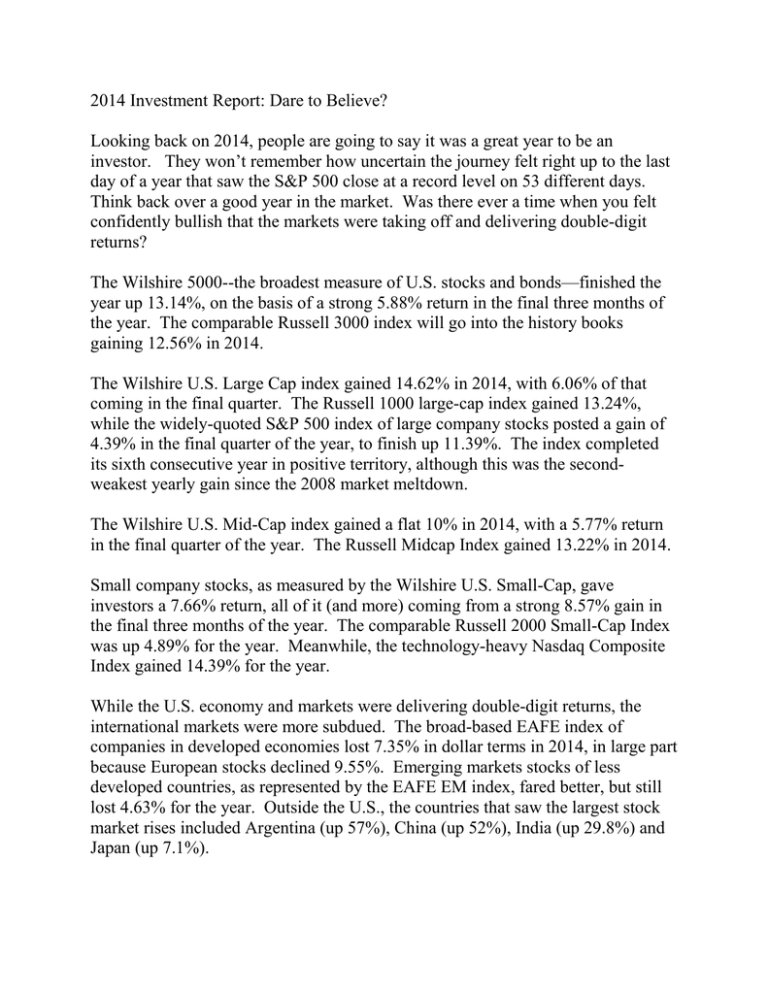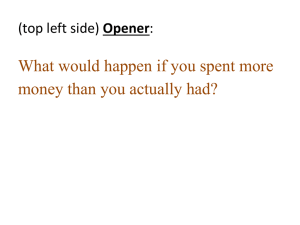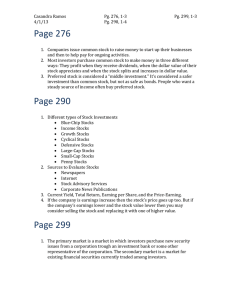2014 In Review: Dare To Believe?
advertisement

2014 Investment Report: Dare to Believe? Looking back on 2014, people are going to say it was a great year to be an investor. They won’t remember how uncertain the journey felt right up to the last day of a year that saw the S&P 500 close at a record level on 53 different days. Think back over a good year in the market. Was there ever a time when you felt confidently bullish that the markets were taking off and delivering double-digit returns? The Wilshire 5000--the broadest measure of U.S. stocks and bonds—finished the year up 13.14%, on the basis of a strong 5.88% return in the final three months of the year. The comparable Russell 3000 index will go into the history books gaining 12.56% in 2014. The Wilshire U.S. Large Cap index gained 14.62% in 2014, with 6.06% of that coming in the final quarter. The Russell 1000 large-cap index gained 13.24%, while the widely-quoted S&P 500 index of large company stocks posted a gain of 4.39% in the final quarter of the year, to finish up 11.39%. The index completed its sixth consecutive year in positive territory, although this was the secondweakest yearly gain since the 2008 market meltdown. The Wilshire U.S. Mid-Cap index gained a flat 10% in 2014, with a 5.77% return in the final quarter of the year. The Russell Midcap Index gained 13.22% in 2014. Small company stocks, as measured by the Wilshire U.S. Small-Cap, gave investors a 7.66% return, all of it (and more) coming from a strong 8.57% gain in the final three months of the year. The comparable Russell 2000 Small-Cap Index was up 4.89% for the year. Meanwhile, the technology-heavy Nasdaq Composite Index gained 14.39% for the year. While the U.S. economy and markets were delivering double-digit returns, the international markets were more subdued. The broad-based EAFE index of companies in developed economies lost 7.35% in dollar terms in 2014, in large part because European stocks declined 9.55%. Emerging markets stocks of less developed countries, as represented by the EAFE EM index, fared better, but still lost 4.63% for the year. Outside the U.S., the countries that saw the largest stock market rises included Argentina (up 57%), China (up 52%), India (up 29.8%) and Japan (up 7.1%). Commodities, as measured by the S&P GSCI index, proved to be an enormous drag on investment portfolios, losing 33.06% of their value, largely because of steep recent drops in gold and oil prices. Part of the reason that U.S. stocks performed so well when investors seemed to be constantly looking over their shoulders is interest rates—specifically, the fact that interest rates remained stubbornly low, aided, in no small part, by a Federal Reserve that seems determined not to let the markets dictate bond yields until the economy is firmly and definitively on its feet. The Bloomberg U.S. Corporate Bond Index now has an effective yield of 3.13%, giving its investors a windfall return of 7.27% for the year due to falling bond rates. 30-year Treasuries are yielding 2.75%, and 10-year Treasuries currently yield 2.17%. At the low end, 3month T-bills are still yielding a miniscule 0.04%; 6-month bills are only slightly more generous, at 0.12%. Normally when the U.S. investment markets have posted six consecutive years of gains, five of them in double-digit territory, you would expect to see a kind of euphoria sweep through the ranks of investors. But for most of 2014, investors in aggregate seemed to vacillate between caution and fear, hanging on every economic and jobs report, paying close attention to the Federal Reserve Board’s pronouncements, seemingly trying to find the bad news in the long, steady economic recovery. One of the most interesting aspects of 2014—and, indeed, the entire U.S. bull market period since 2009—is that so many people think portfolio diversification was a bad thing for their wealth. When global stocks are down compared with the U.S. markets, U.S. investors tend to look at their statements and wonder why they’re lagging the S&P index that they see on the nightly news. This year, commodity-related investments were also down significantly, producing even more drag during what was otherwise a good investment year. But that’s the point of diversification: when the year began, none of us knew whether the U.S., Europe, both or neither would finish the year in positive territory. Holding some of each is a prudent strategy, yet the eye inevitably turns to the declining investment which, in hindsight, pulled the overall returns down a bit. At the end of next year, we may be looking at U.S. stocks with the same gimlet eye and feeling grateful that we were invested in global stocks as a way to contain the damage; there’s no way to know in advance. Is a decline in U.S. stocks likely? One can never predict these things in advance, but the usual recipe for a terrible market year is a period right beforehand when investors finally throw caution to the winds, and those who never joined the bull market run decide it’s time to crash the party. The markets have a habit of punishing overconfidence, but we don’t seem to be seeing that quite yet. What we ARE seeing is kind of boring: a long, slow economic recovery in the U.S., a slow housing recovery, healthy but not spectacular job creation in the U.S., stagnation and fears of another Greek default in Europe, stocks trading at values slightly higher than historical norms and a Fed policy that seems to be waiting for certainty or a Sign from Above that the recovery will survive a return to normal interest rates. On the plus side, we also saw a 46% decline in crude oil prices, saving U.S. drivers approximately $14 billion this year. The Fed has signaled that it plans to take its foot off of interest rates sometime in the middle of next year. The questions that nobody can answer are important ones: Will the recovery gain steam and make stocks more valuable in the year ahead? Will Europe stabilize and ultimately recover, raising the value of European stocks? Will oil prices remain low, giving a continuing boost to the economy? Or will, contrary to long history, the markets flop without any kind of a euphoric top? We can’t answer any of these questions, of course. What we do know is that since 1958, the U.S. markets, as measured by the S&P 500 index, have been up 53% of all trading days, 58% of all months, 63% of all quarters and 72% of the years. Over 10-year rolling time periods, the markets have been up 88% of the time. These figures do not include the value of the dividends that investors were paid for hanging onto their stock investments during each of the time periods. Yet since 1875, the S&P 500 has never risen for seven calendar years in a row. Could 2015 break that streak? Stay tuned. Sources: Wilshire index data: http://www.wilshire.com/Indexes/calculator/ Russell index data: http://www.russell.com/indexes/data/daily_total_returns_us.asp S&P index data: http://www.standardandpoors.com/indices/sp500/en/us/?indexId=spusa-500-usduf--p-us-l-http://money.cnn.com/2014/09/30/investing/stocks-market-septemberslump/index.html Nasdaq index data: http://quicktake.morningstar.com/Index/IndexCharts.aspx?Symbol=COMP International indices: http://www.mscibarra.com/products/indices/international_equity_indices/performa nce.html Commodities index data: http://us.spindices.com/index-family/commodities/spgsci Treasury market rates: http://www.bloomberg.com/markets/ratesbonds/government-bonds/us/ http://blogs.marketwatch.com/thetell/2014/06/30/one-chart-explains-theunexpected-first-half-treasury-rally/ Aggregate corporate bond rates: https://indices.barcap.com/show?url=Benchmark_Indices/Aggregate/Bond_Indices Aggregate corporate bond rates: http://www.bloomberg.com/markets/ratesbonds/corporate-bonds/ http://www.reuters.com/article/2014/12/31/us-usa-markets-2015-analysisidUSKBN0K908820141231 http://moneyover55.about.com/od/howtoinvest/a/bearmarkets.htm?utm_term=histo rical%20performance%20of%20s&p%20500&utm_content=p1-main-7title&utm_medium=sem&utm_source=msn&utm_campaign=adid-ac372107-3fb54c61-a1f3-6ab4e1340551-0-ab_msb_ocode28813&ad=semD&an=msn_s&am=broad&q=historical%20performance%20of%2 0s&p%20500&dqi=S%2526P%2520500%2520yearly%2520performance&o=288 13&l=sem&qsrc=999&askid=ac372107-3fb5-4c61-a1f3-6ab4e1340551-0-ab_msb




